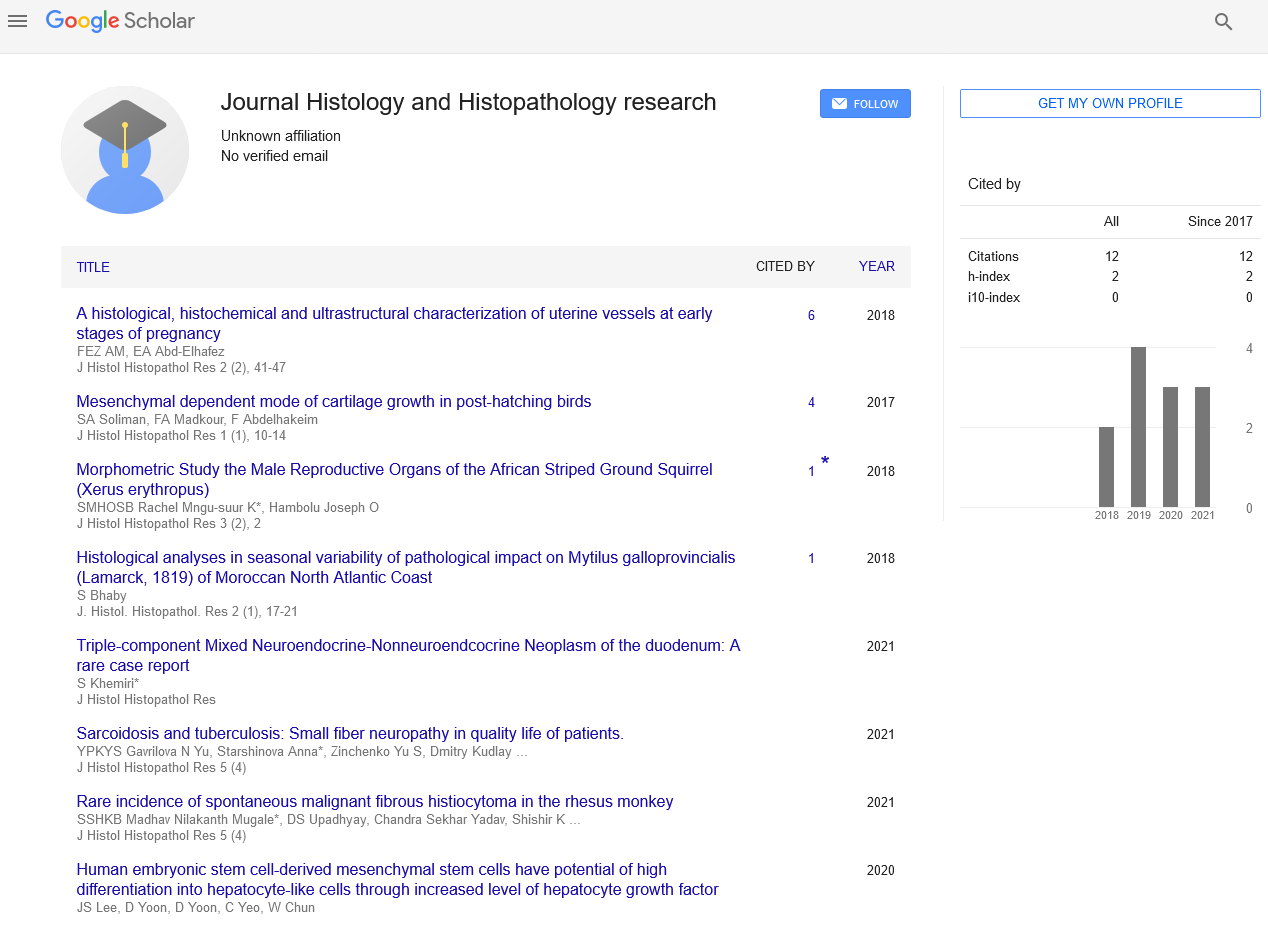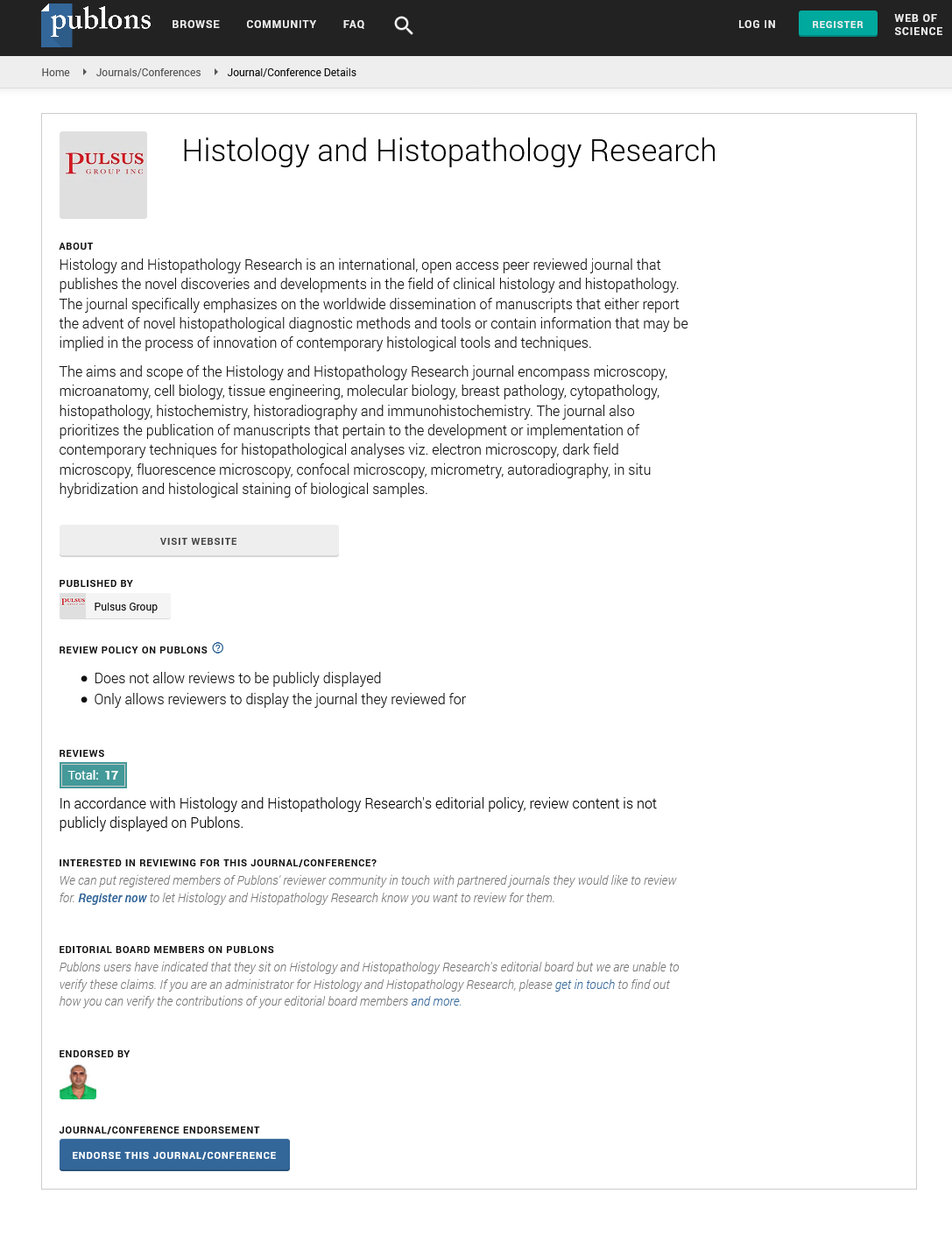Molecular mechanisms of autophagy after traumatic brain injury
2 Department of Forensic Medicine, Medical College of Soochow University, Suzhou 215123, China, Email: clluo@suda.edu.cn
Received: 03-Oct-2017 Accepted Date: Oct 09, 2017; Published: 15-Oct-2017
Citation: Li Q, Luo C, Tao L. Molecular mechanisms of autophagy after traumatic brain injury. J Histol Histopathol Res. 2017;1(1):8-9.
This open-access article is distributed under the terms of the Creative Commons Attribution Non-Commercial License (CC BY-NC) (http://creativecommons.org/licenses/by-nc/4.0/), which permits reuse, distribution and reproduction of the article, provided that the original work is properly cited and the reuse is restricted to noncommercial purposes. For commercial reuse, contact reprints@pulsus.com
Traumatic brain injury (TBI), one of major causes of substantial morbidity and mortality, remains a significant worldwide medical concern as a considerable cause of death and permanent disability among young adults and children, imposing a significant burden on society [1], and leads to the risk for long-term disability and psychiatric disorders in cognition and personality [2]. The pathology of TBI involves primary mechanical injury and a secondary injury. Nevertheless, the traumatic damage to the injured brain is caused by the secondary injury that exacerbates the primary injury [3]. Therefore, TBI is a significant clinical problem with few therapeutic interventions successfully translated to the clinic.
Autophagy is an evolutionarily conserved pathway that leads to degradation of proteins and entire organelles in cells undergoing stress [4]. Three kinds of autophagy exist: macroautophagy [general autophagy], microautophagy, and chaperone-mediated autophagy [5]. Microautophagy involves the direct engulfment of the cargo by the lysosomal membrane. Chaperone-mediated autophagy is characterized by transfer of cytosolic proteins with a KFERQ motif to the lysosome by chaperone proteins, and their direct import through the lysosomal-associated membrane protein type 2A translocation complex. Finally, macroautophagy [hereafter simply called autophagy], is the most studied type of autophagy, and involves the formation of the autophagosome [a double-membrane vesicle]. The autophagosome subsequently fuses with the lysosome to form autolysosomes [6].
Currently, p62/SQSTM1 is identified as one of the specific substrates that are degraded through the autophagy pathway [7,8]. This degradation is mediated by interaction with LC3, a mammalian homologue of Atg8, which is recruited to the phagophore/isolation membrane and remains associated with the completed autophagosome [9,10]. 3-methyladenine (3-MA), a relatively selective inhibitor of the Class III phoshatidylinositol- 3-kinase (PI3K), is used to study the autophagy pathway [11,12]. PI3K can interact with Beclin-1 to participate in the formation of autophagosomes [11]. In addition, by inhibiting vacuolar H+-ATPase, bafliomycin A1 (BFA) can inhibit autophagy [13].
Autophagic cell death has been reported as one type of programmed cell death. However, whether this is death due to autophagy or death coincident with autophagy remains controversial [14]. Autophagy is used to maintain cell viability via the bulk degradation of cytoplasmic material by generating amino acids and energy, during the conditions of nutrient limitation [15]. Moreover, the presence of autophagy in dying cells has been reported to be a stress response mechanism to prolong cell viability. However, recent studies strongly support the notion that autophagy is a process that can promote and affect programmed cell death [16].
Many of the original studies describing autophagy-induced death relied on the observation of autophagy in dying cells and did not examine autophagic flux [15]. In autophagic flux studies, while enhanced autophagy flux may exert neuroprotection after TBI, and inhibition of autophagy flux may contribute to neuronal cell, suggusting disruption of autophagy maybe a part of the secondary injury mechanism [17,18]. Based on the observations of enhanced morphological features [such as accumulation of autophagic vesicles] in dying cells, the concept of autophagic cell death was proposed [19]. Recently, a novel form of autophagy-dependent cell death has been described, autosis, which not only meets the criteria in claim [i.e., blocked by autophagy inhibition, independent of apoptosis or necrosis], but also demonstrates unique morphological features and a unique ability to be suppressed by pharmacological or genetic inhibition of the NaC, KCATPase [20].
Recent studies have shown that autophagy is increased after TBI [21,22]. Up-regulation of LC3 immunostaining is observed mainly in neurons at 24 h following TBI [23]. However, few experimental studies have addressed the effects of autophagy on traumatic damage and neurologic outcome. By using autophagic inhibitors such as 3-MA and bafliomycin A1 (BFA), our study indicate that autophagy contributes to the pathophysiologic responses following TBI, and inhibition of autophagy may help alleviate TBI-induced damage and behavior outcome dysfunction [12].
Autophagy flux is the pathway of the cargos traveling by the autophagy system and resulting in its delivery and degradation in the organelles named lysosomes [24]. The study also indicated that the autophagy flux was increased in the TBI models, and the expression level of p62/SQSTM1 protein was decreased; whereas when autophagy flux is inhibited, the level of p62/SQSTM1 was increased [24]. However, the controversial functions and underlying mechanisms of autophagy following TBI still needed to be further address in the future.
REFERENCES
- Jin Y, Lin Y, Feng JF, et al. Attenuation of cell death in injured cortex following post-traumatic brain injury moderate hypothermia: possible involvement of autophagy pathway. World Neurosurg 2015;84:420–30.
- Santopietro J, Yeomans JA, Niemeier JP, et al. Traumatic brain injury and behavioral health: the state of treatment and policy. N C Med J 2015;76:96–100.
- Mustafa AG, Singh IN, Wang J, et al. Mitochondrial protection after traumatic brain injury by scavenging lipid peroxyl radicals. J Neurochem 2010;114:271–80.
- Pozuelo-Rubio M. 14-3-3_ binds class III phosphatidylinositol-3-kinase and inhibits autophagy. Autophagy 2011;7:240–42.
- Klionsky DJ. The molecular machinery of autophagy: unanswered questions. J Cell Sci 2005;118:7–18.
- Wesselborg S, Stork B. Autophagy signal transduction by ATG proteins: from hierarchies to networks. Cell Mol Life Sci 2015;72:4721–57.
- Ichimura Y, Kumanomidou T, Sou YS, et al. Structural basis for sorting mechanism of p62 in selective autophagy. J Biol Chem 2008;283:22847–57.
- Komatsu M, Ichimura Y. Physiological significance of selective degradation of p62 by autophagy. FEBS Lett 2010;584:1374–78.
- Pankiv S, Clausen TH, Lamark T, et al. p62/SQSTM1 binds directly to Atg8/LC3 to facilitate degradation of ubiquitinated protein aggregates by autophagy. J Biol Chem 2007;282:24131–145.
- Zheng YT, Shahnazari S, Brech A, et al. The adaptor protein p62/SQSTM1 targets invading bacteria to the autophagy pathway. J Immunol 2009;183:5909–16.
- Petiot A, Ogier-Denis E, Blommaart EF, et al. Distinct classes of phosphatidylinositol 3’-kinases are involved in signaling pathways that control macroautophagy in HT-29 cells. J Biol Chem 2000;275:992–8.
- Luo CL, Li BX, Li QQ, et al. Autophagy is involved in traumatic brain injury-induced cell death and contributes to functional outcome deficits in mice. Neuroscience 2011;184(16):54-63.
- Boya P, Gonzalez-Polo RA, Casares N, et al. Inhibition of macroautophagy triggers apoptosis. Mol Cell Biol 25:1025–1040.
- Kroemer G, Levine B. Autophagic cell death: the story of a misnomer. Nat Rev Mol Cell Biol 2005;9:1004–10.
- Messer JS. The cellular autophagy/apoptosis checkpoint during inflammation. Cell Mol Life Sci 2016.
- Lin L, Baehrecke EH. Autophagy, cell death, and cancer. Mol Cell Oncol. 2015;2(3):e985913.
- Sarkar C, Zhao Z, Aungst S, et al. Impaired autophagy flux is associated with neuronal cell death after traumatic brain injury. Autophagy 2014;10(12):2208-22.
- Lipinski MM, Wu J, Faden AI, et al. Function and mechanisms of autophagy in brain and spinal cord trauma. Antioxid Redox Signal 2015;23(6):565-77.
- Galluzzi L, Vitale I, Abrams JM, et al. Molecular definitions of cell death subroutines: recommendations of the Nomenclature Committee on Cell Death 2012. Cell Death and Differentiation 2014;19(1):107–120.
- Liu Y, Shoji-Kawata S, Sumpter RM, et al. Autosis is a NaC, KC-ATPase-regulated form of cell death triggered by autophagy inducing peptides, starvation, and hypoxia-ischemia. Proc Natl Acad Sci USA 2013;10:20364-71.
- Lai Y, Hickey RW, Chen Y, et al. Autophagy is increased after traumatic brain injury in mice and is partially inhibited by the antioxidant gamma-glutamylcysteinyl ethyl ester. J Cereb Blood Flow Metab 2008;28:540–50.
- Zhang YB, Li SX, Chen XP, et al. Autophagy is activated and might protect neurons from degeneration after traumatic brain injury. Neurosci Bull. 2008;24(3):143-9.
- Liu CL, Chen S, Dietrich D, et al. Changes in autophagy after traumatic brain injury. J Cereb Blood Flow Metab 2008;28:674–83.
- Fukui K, Ushiki K, Takatsu H, et al. Tocotrienols prevent hydrogen peroxide-induced axon and dendrite degeneration in cerebellar granule cells. Free Radic Res 2012;46(2):184–93.






